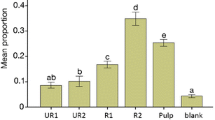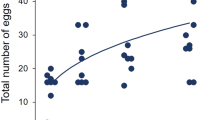Abstract
Groups of female Mediterranean fruit flies, Ceratitis capitata(Wiedemann), were exposed for several days to one of three host fruit species. Oviposition-site acceptance behavior was subsequently assayed on five fruit species. Females accepted most often the fruit to which they were exposed. Females exposed to a small fruit, mock orange, accepted other fruit species less often as the size of the fruit increased; females exposed to a large fruit, sweet orange, accepted other fruit species more often as the size of the fruit increased. This tendency for experience with one host fruit species to alter differentially behavioral responses to alternative host fruit species has been defined as cross-induction. In contrast, females exposed to a medium fruit, kumquat, were not cross-induced: females accepted the medium fruit very often and rejected all other fruit species to approximately the same degree regardless of size. When females were exposed to small, medium, or large fruit and tested on spherical wax fruit models of a variety of sizes, patterns similar to those with real fruit were observed. Whereas naive females generally accepted a given model as frequently as real fruit of a similar size, experienced females generally accepted models much less frequently than real fruit. In a final experiment, females were exposed to different fruits and tested on spherical wax models treated with fruit chemicals. Experienced females generally accepted fruit-treated spheres more often than untreated spheres. In addition, females usually accepted most often models treated with chemicals from the fruit to which they were exposed. Two hypotheses about the mechanism by which experience alters fruit acceptance— termed the “sliding template” and “closing window” hypotheses— are presented. Results of fruit and model acceptance by naive and experienced females support the latter hypothesis.
Similar content being viewed by others
References
Cooley, S. S., Prokopy, R. J., McDonald, P. T., and Wong, T. T. Y. (1986). Learning in oviposition site selection byCeratitis capitata flies.Entomol. Exp. Appl. 40: 47–51.
Diehl, S. R., and Prokopy, R. J. (1985). Host selection behavior differences between the fruit fly sibling speciesRhagoletis pomonella andR. mendax (Diptera: Tephritidae).Ann. Entomol. Soc. Am. 79: 266–271.
Harris, M. O., and Miller, J. R. (1982). Synergism of visual and chemical stimuli in the oviposition behavior ofDelia antiqua. InProceedings, 5th International Symposium on Insect-Plant Relationships, Pudoc, Wageningen, The Netherlands, pp. 117–122.
Jaenike, J. (1983). Induction of host preference inDrosophila melanogaster. Oecologia58: 320–325.
Katsoyannos, B. I., and Pittara, I. S. (1983). Effect of size of artificial oviposition substrates and presence of natural host fruits on the selection of oviposition site byDacus oelae.Entomol. Exp. Appl. 34: 326–332.
Papaj, D. R., and Prokopy, R. J. (1986). Phytochemical basis of learning inRhagoletis pomonella and other herbivorous insects.J. Chem. Ecol. 12: 1125–1143.
Papaj, D. R., and Prokopy, R. J. (1987). Learning of host acceptance in the apple maggot fly,Rhagoletis pomonella: The role of fruit size. In Labeyrie, V., Fabres, G., and Lachaise, D. (eds.),Proceedings, 6th International Symposium on Insect-Host Plant Relationships, Junks, Dordrecht, The Netherlands, p. 408.
Papaj, D. R., Prokopy, R. J., McDonald, P. T., and Wong, T. T. Y. (1987). Differences in learning between wild and laboratoryCeratitis capitata. Entomol. Exp. Appl.45: 65–72.
Prokopy, R. J., and Boller, E. F. (1971). Stimuli eliciting oviposition of European cherry fruit flies,Rhagoletis cerasi L., into inanimate objects.Entomol. Exp. Appl. 14: 1–14.
Prokopy, R. J., and Bush, G. L. (1973). Ovipositional responses to different sizes of artificial fruit by flies ofRhagoletis pomonella species group.Ann. Entomol. Soc. Am. 66: 927–929.
Prokopy, R. J., Aluja, M., and Green, T. A. (1987). Dynamics of host odor and visual stimulus interaction in host finding behavior of apple maggot flies. In Labeyrie, V., Fabres, G., and Lachaise, D. (eds.),Proceedings, 6th International Symposium on Insect-Host Plant Relationships, Junks, Dordrecht, The Netherlands, pp. 161–166.
SAS Institute. (1985).SAS User's Guide, Version 5 Edition. Cary, North Carolina, U.S.A.
STSC Corp. (1986).Statgraphics, Statistical Graphics System, Rockville, Maryland, U.S.A.
Tanaka, N., Steiner, L. F., Ohinata, K., and Okamoto, R. (1969). Low-cost larval rearing medium for mass production of oriental and Mediterranean fruit flies.J. Econ. Entomol. 62: 967–968.
Wong, T. T. Y., and Nakahara, L. M. (1978). Sexual development and mating response of laboratory-reared and native Mediterraneanfruit flies.Ann. Entomol. Am. 71: 592–596.
Author information
Authors and Affiliations
Rights and permissions
About this article
Cite this article
Papaj, D.R., Opp, S.B., Prokopy, R.J. et al. Cross-induction of fruit acceptance by the medflyCeratitis capitata: The role of fruit size and chemistry. J Insect Behav 2, 241–254 (1989). https://doi.org/10.1007/BF01053295
Accepted:
Issue Date:
DOI: https://doi.org/10.1007/BF01053295




